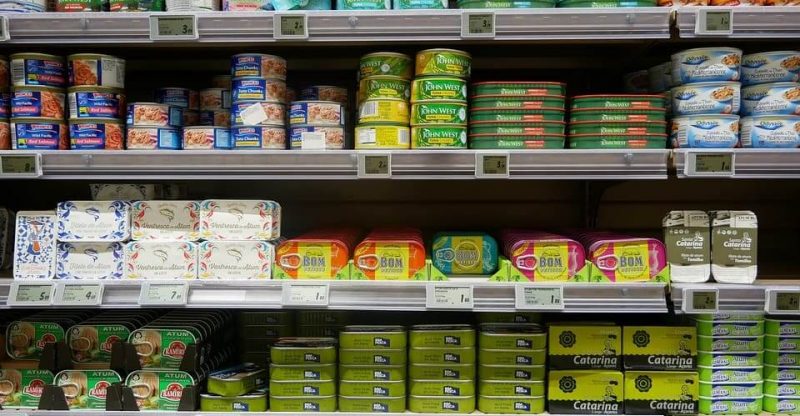What is Sodium Acid Pyrophosphate E450(i) in Food: Uses, Safety, Side effects

What is it | Production | Safety | Side Effects | FAQs
Sodium acid pyrophosphate (SAPP), or disodium dihydrogen pyrophosphate, its food grade is commonly used with sodium bicarbonate as a leavening agent in bakery products; also, it maintains the color in processed potatoes and also prevents struvite crystal in canned seafood. The European food additive number for it is E450(i). Generally, it is vegan and gluten free.
What is Sodium Acid Pyrophosphate?
SAPP is an inorganic compound consisting of sodium cations and pyrophosphate anion. It is used in food mainly for its two properties:
- As a leavening acid which combines with baking soda to release carbon dioxide to improve the texture and volume of baked goods.
- As a chelating agent to chelate iron to prevent discoloration in processed potato.
How is it Made?
SAPP is a condensed phosphate, commonly synthesized by the neutralization of phosphoric acid with sodium hydroxide or sodium carbonate at the ratio of 1:1 to produce monosodium phosphate (NaH2PO4), and then heated approximately 250°C to remove the water.
2 NaH2PO4 → Na2H2P2O7 + H2O
Properties
Appearance
White free-flowing crystalline powder or granular. SAPP would hydrolyze to sodium orthophosphate if exposed to the environment.
Solubility
10g/100ml, 20°C in water. The PH value of 1% solution 4-4.5. Insoluble in ethanol.
Other Names
- Disodium Pyrophosphate
- Disodium Diphosphate
- Disodium Dihydrogen Diphosphate
- Disodium Dihydrogen Pyrophosphate
- Diphosphoric Acid, Disodium Salt
- Pyrophosphoric Acid, Disodium Salt
CAS Number
7758-16-9
Chemical formula
Na2H2P2O7
Molecular Weight
221.94
What are the Uses of Sodium Acid Pyrophosphate?
Generally, SAPP food grade is used as an acid component in baking powder; as a chelating agent or combines with other polyphosphates to sequester magnesium and iron ions, e.g. chelate iron during the processing of potatoes to prevent a dark discoloration.
In the bakery, it is a slow leavening acid and it may contain a suitable aluminum and/or calcium salt to control the rate of reaction.
Bakery
SAPP is used together with baking powder as a leavening agent to release carbon dioxide. It is ideal for refrigerated doughs, cakes, muffins and pancake mixes where a slow reaction rate is desired.
It is often used with fast-acting leavenings such as monocalcium phosphate in double-acting baking powder or sometimes added with another slow action leavening acid, GDL.
Both SAPP and GDL have a slightly bitter aftertaste.
Canned seafood
Struvite crystal is occasionally found in canned seafood, and SAPP is used to inhibit its formation, such as in canned tuna. (1)
Potato products
SAPP can be used to replace sulfur dioxide, sulfites and bisulfites to maintain the appearance and texture of cooked potato products. The application of SAPP reduces the dark color from after-cooking darkening in cooked and processed potato products, such as in oil-blanched french fries and potato salad.
It is the naturally present or equipment iron that generates “after cooking darkening” in potatoes. SAPP stabilizes the color of potatoes and prevents the iron complex from forming a dark pigment due to its strong sequestering properties.
Is Sodium acid pyrophosphate Safe?
Yes, its safety when used as a food additive has been approved by the U.S. Food and Drug Administration (FDA), European Food Safety Authority (EFSA), Joint FAO/WHO Expert Committee on Food Additives (JECFA), as well as other authorities.
FDA
SAPP is generally recognized as safe when used in accordance with good manufacturing practice (2) AND can be used as a color or coloring adjunct, dough strengthener, emulsifier or emulsifier salt, flavoring agent or adjuvant, flour treating agent, formulation aid, leavening agent, oxidizing or reducing agent, and sequestrant in food. (3)
EFSA
Disodium diphosphate (E450i) is listed in Commission Regulation (EU) No 231/2012 as an authorised food additive and categorized as “additives other than colours and sweeteners” (4)
Safety re-evaluation in 2019
In 2019, EFSA considered disodium pyrophosphate to be of low acute oral toxicity and there was no concern with respect to genotoxicity and carcinogenicity.
Also, no effects were reported in developmental toxicity studies. EFSA derived a group acceptable daily intake (ADI) for phosphates expressed as phosphorus of 40 mg/kg body weight (bw) per day and concluded that this ADI is protective for the human population.
Authorised Uses And Use Levels
Its application is listed in diphosphates E450 and the max uses level is 5000 (mg/l or mg/kg as appropriate).
The following foods may contain with it (5):
- Processed fish and fishery products
- Biscuits and rusks
UK Food Standards Agency
Categorized in “Others” (6)
Food Standards Australia New Zealand
It is an approved ingredient in Australia and New Zealand with the code number 450. (7)
JECFA
Function Class: food additives, acidity regulator, raising agent, sequestrant. (8)
Tolerable Intake: MTDI 70 mg/kg bw (as P) set in 1982. (9)
What are the Possible Side Effects?
It is common that sometimes consumers have questions whether sodium acid pyrophosphate is bad for our health and what are the possible health risks. We understand that consumers prefer natural food additives and have concerns about the synthesized ingredients in the foods we eat. It is generally considered safe but some people may be allergic or sensitive to it.
Is it Safe for Pregnant?
Yes, it is generally safe but better consult with your doctor in the condition of use.
Frequently asked questions
Is it Natural?
No, it is made from chemical synthesis.
Is it Vegan?
Yes, it is vegan as the raw materials phosphoric acid (from phosphate rocks) and sodium hydroxide or sodium carbonate (from trona ore) are not animal-derived. So SAPP is vegan and suitable for the diet of vegetarians.
Is it Halal?
Yes, it is generally recognised as halal as it is permitted under the Islamic Law and fulfill the conditions of Halal. And we can find some manufacturers certificated with MUI halal.
Is it Kosher?
Yes, it is kosher pareve. E450(i) has met all the “kashruth” requirements and can be certified as kosher.
Is it Gluten Free?
Yes, it is typically gluten-free and people with celiacs can eat it. It is an ingredient commonly found in both gluten-free and gluten-containing food labels. The manufacturing process complies with the FDA’s definition of gluten free, that it does not contain wheat, rye, barley, or crossbreeds of these grains.
Is SAPP A Preservative?
No information sources reviewed that function/purpose of SAPP is as a preservative.
Conclusion
After reading, you may have a good understanding of sodium acid pyrophosphate (E450i), from its production; 3 main food uses: bakery, canned sea food and potatoes; approved safety; possible side effects and some FAQs such as is it vegan, gluten free, synthetic or natural and etc.
What kinds of food packaging have you found this ingredient in? Let me know in the comments.



I found it in frozen chicken breast
Hi Basima,
Thanks for your information.
Hello sir
What Is Sodium Acid Pyrophosphate Permitted Maximum Usage Levels IN MEAT PRODCTS ?
It is an ingredient in Cavendish frozen crispy french fries. Ingredients:
Potatoes, vegetable oil (soybean and/or canola oil), wheat flour, modified corn starch, rice flour, yellow corn meal, salt, baking powder, malted barley flour, guar gum, sodium acid pyrophosphate, dextrose.
Hi Dena,
Thanks for your detailed information.
I found it canned crab.
What are side effects as my husband gets bad nausea and indigestion when eating cookies with this in them.
I found it in Marks and Spencer’s frozen GF fish. E450
Can you post what reported side effects/symptoms present themselves from casually-regularly consuming E450?
This would extremely valuable for those looking to understand what they are putting in their body.
Thanks in advance!
I had a severe allergic reaction to pasteurized canned crab meat containing sodium acid pyrophosphate . Requiring Benadryl and IV steroids. And a ride to the hospital by ambo I have never been allergic to crab meat in my life. Is it possible I could be allergic to this additive ?
It’s hard to say
Thanks for your article. A very detailed introduction to SAPP, I believe it will be of great help to those who want to learn about this food additive.
I found this in Bob Redmill baking powder.
I am obviously not a scientist and am not an expert by any stretch but I can speak as a lay person about my experiences with what I’ve learned as a result of my experience with SAPP.
I beg to differ with the safety of this ingredient. After I had a horrendous reaction to it and after doing some research, discovered it isn’t so innocent as we have been led to believe. Trader Joes uses it or at least did use it — am not sure if they still do but I suspect they might, in their baked goods. This is not a safe product. BSpink asked if one could be allergic to this? Yes. Research has shown that not only can people have an allergy to it, it can cause other problems such as GI upset: gassiness, nausea, stomach upset, cramps and vomiting, including abdominal pain and a bloated feeling. But that’s not all. Sodium phosphate has been ‘associated with’ severe kidney damage, sometimes requiring dialysis, according to a 2009 article in PubMed Health. And how about this nice addition to all of the above: phosphate in sodium phosphate can cause calcification of organs according to the University of Maryland Medical Center. ‘Phosphate can cause soft tissue to calcify. therefore, when organs and soft tissue become calcified, the ability to utilize minerals becomes impaired. (Joseph Pritchard, Nov 2018).
Another study was conducted where SAPP was evaluated in rats, and it was found that SAPP can also have hemato-immunotoxic effects. The study said, “a significant leukopenic condition was observed with SAPP and marked decrease in CD3 T-lymphocyte and CD20 B-lymphocyte immunolabeling in rats treated with SAPP.” Now, granted this study used higher doses, however, that doesn’t mean that one must ingest high doses in order to have such reactions. All it takes is a sensitivity to it or an ongoing consumption of prepared foods with that ingredient to develop these health problems. Sourced from: “Effects of the food additives sodium acid pyrophosphate, sodium acetate, and citric acid on hemato-immunological pathological biomarkers in rats.”
The point I wanted to make is, I bought what many people eat: prepared muffin (mix) by Trader Joes (brand) never thinking I would experience such a horrendous reaction. In my view, this should never be allowed to be ingested in any food or substance. The sad thing is that because we’re so busy we have become dependent on a food industry to prepare our food for us to make our lives easier. But with that reliannce comes great cost. We have become a very sick society, all the while never suspecting the problem just might be in the prepared food ingredients that we’re eating on a daily basis. It may help extend shelf life, or act as an emulsifier, or perform some other action to produce mass quantities of food but in the end, is it worth it?
Is it any wonder why America, the country that relies heavily on chemicals for everything, has such high rates of disease?
i found it is Southern Comfort Hinds bread crumbs.
many food additives do indeed cause reactions in some people. they should be the indicator for the rest of us who arent as sensitive.
Hi, I have an allergy to E additives mainly characterised by becoming hyperactive however I have noticed this particular additive is increasingly causing me no end of issues from disturbed sleep, swollen eyes, mild breathing problems and an overall feeing of unease and feeing unwell. Similar to anaphylaxis but not as extreme. This additive needs to be in bold. I accept it is mostly safe but for those of us who are sensitive it needs to be more obvious in the ingredient list.
Thanks
Sadly, the U.S. FDA is a compromised agency as is the WHO. After all, they both approved the poisonous covid shots that have killed and seriously injured thousands of people. They routinely approve substances that are harmful to our health and bodies. Anything synthetic is not good for us! I agree with Bugg, we need to stop relying on chemicals in our food products!
In reply to Becky M you seem to be describing how I’m feeling after eating crumpets containing E450. The only thing I’m not experiencing is swollen eyes. I do have a lot of problems with additives which appears to have been exacerbated since the COVID vacc.